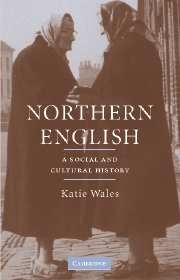Book contents
- Frontmatter
- Contents
- List of illustrations
- Preface
- List of abbreviations and symbols
- 1 ‘The North–South divide’
- 2 The origins of Northern English
- 3 Northern English and the rise of ‘Standard English’
- 4 Northern English after the Industrial Revolution (1750–1950)
- 5 Northern English present and future
- References
- Index of Northern English features
- General index
1 - ‘The North–South divide’
Published online by Cambridge University Press: 22 September 2009
- Frontmatter
- Contents
- List of illustrations
- Preface
- List of abbreviations and symbols
- 1 ‘The North–South divide’
- 2 The origins of Northern English
- 3 Northern English and the rise of ‘Standard English’
- 4 Northern English after the Industrial Revolution (1750–1950)
- 5 Northern English present and future
- References
- Index of Northern English features
- General index
Summary
Introduction: an ‘alternative’ history of English
Imagine a map of England upside down, as if London was not in the South-east, but ‘Up North’ in the far North-west, where Carlisle should be; and as if Lancaster was roughly in London's present location ‘Down South’, with Berwick the furthest point south. Even with the map the right way up, and Scotland included, it is hard to accept the fact that, as Cumbrian-born Melvyn Bragg has stated ([1976] 1987: 15) ‘Wigton is the middle of the British Isles’. (Pearce (2000: 172 claims Dunsop Bridge in Lancashire for this same ‘epicentre’.) For a rich variety of reasons, some of which will be explored in this book, the perceived centre of national gravity, so to speak, whether culturally, politically or economically, is ‘Down South’, particularly London and its ‘Home’ Counties, and this is certainly embedded in history; but one of my major aims is to upturn common conceptions of regions by changing the perspective. In focussing on the North of England and Northern English, a region and a dialect with a history that stretches far back before the Norman Conquest, the aim is also to turn upside down common conceptions of the history of the English language by inverting accepted hierarchies of influence and prestige.
By sheer coincidence this same metaphor recurs on the dust-jacket of a recent book by David Crystal, The Stories of English (2004).
- Type
- Chapter
- Information
- Northern EnglishA Social and Cultural History, pp. 1 - 31Publisher: Cambridge University PressPrint publication year: 2006

